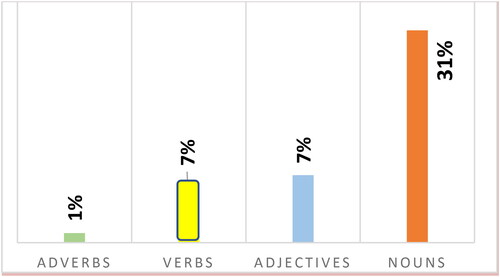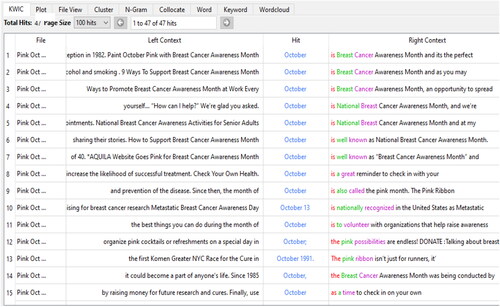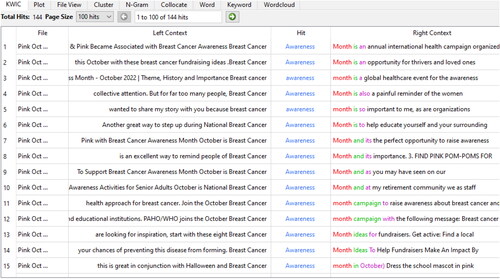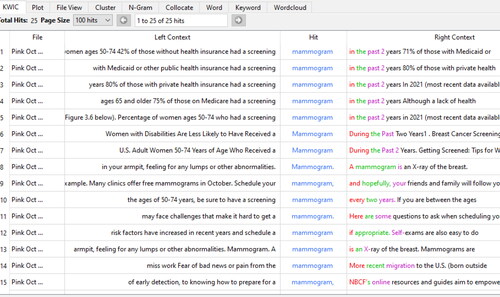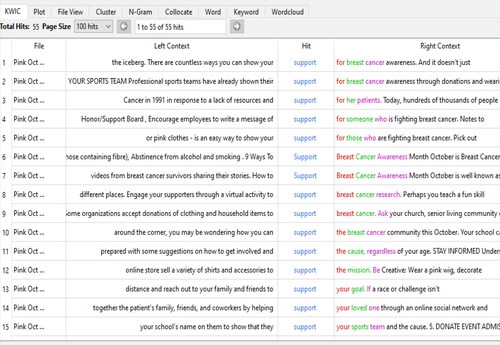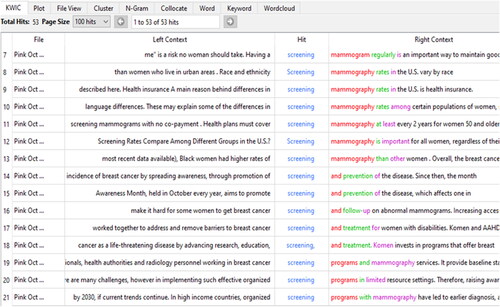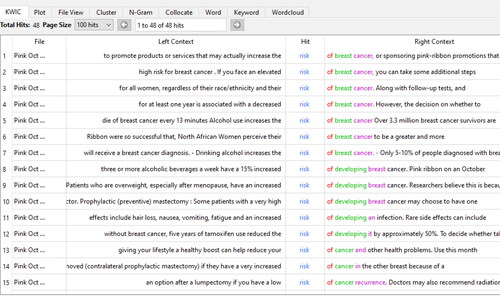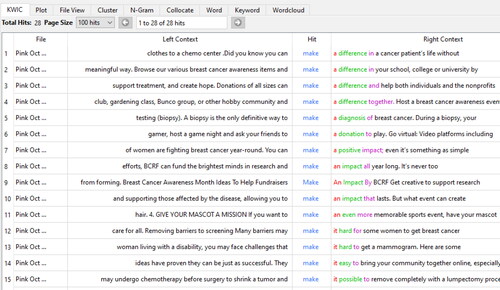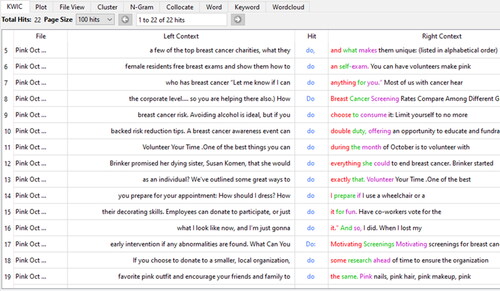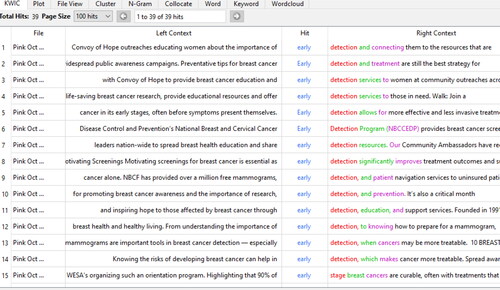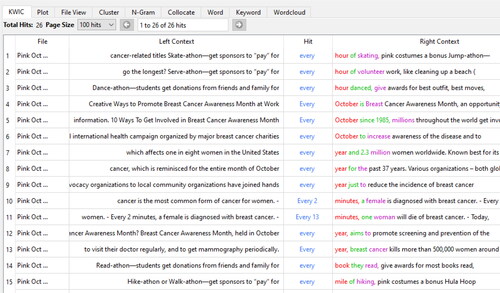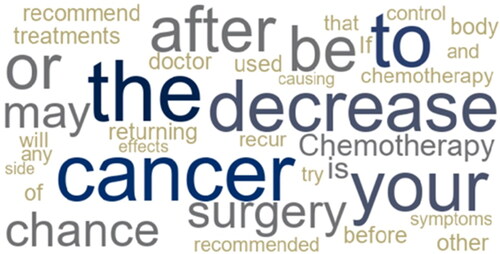Abstract
Women’s health is a significant topic of discussion in Pink October campaigns. These campaigns seek to increase awareness of both breast cancer and women’s general health. This study aims to examine the textual strategies in health communication. This is achieved by applying corpus stylistic tools to investigate linguistic patterns in Pink October campaigns to boost women’s health. The corpus of the study is built from twenty-two websites and it has 16908 words. The data are examined using the eclectic model of McIntyre and Walker (Citation2019) and Leech and Short (Citation2007) frameworks. The quantitative analysis is achieved by using AntConc software to gain an objective, systematic statistical overview of the corpus. The study focuses on word frequency list and keywords in context. The results show that in the distribution of content words, nouns are the most frequently used which are followed by verbs, adjectives and adverbs. Moreover, healthcare practitioners employ a variety of strategies, such as plain language and avoiding jargon so their messages in the campaigns can reach a broad audience from different ages and backgrounds.
1. Introduction
Social media and Pink October campaigns effectively influence public awareness of breast cancer, and this affects women’s collective actions. It is believed that using media campaigns to raise awareness of breast cancer care can educate women on the practice of breast self-examination and the necessary regular checkups. Media awareness campaigns are essential for health communication because they make great use of the widespread to convey information while also offering opportunities for interventions to alter behaviour (Nelson, Citation2016, pp.160–161). One of the most dangerous diseases affecting women is breast cancer. With an expected 2.3 million new cases globally in 2020, female breast cancer will surpass lung cancer as the most common cancer diagnosed. Breast cancer is one of the most common types of cancer worldwide (Biancovilli et al., Citation2021, p.1).
The concept of health communication is broad and inclusive, encompassing an extensive scope of communicative activities related to healthcare and wellness, from private accounts of health and illness and interactions with medical professionals to documentation of health policies and side effects details provided on medication packing (Harvey & Adolphs, Citation2011). Health communication is a broad field of study that includes a variety of written and spoken texts as well as emerging digital modes of communication that are increasingly used to mediate modern healthcare and public health messaging (Brookes & Hunt, Citation2021, p.2). According to Jones (Citation2013), the emphasis in industrial societies has shifted from communicable illnesses to lifestyle-related illnesses that can be avoided. This has resulted in the emergence of multiple discourses that attribute illness more to personal behaviour than to external risks. He continues, ‘[t]he focus of health-related discourse has moved away from the curing of illness to the maintenance of health’, where ‘health has become not just a matter of physical, mental and social well-being, but primarily a discursive exercise of constantly reproducing ‘health’ in our daily lives as part of ongoing identity projects’ (Jones, Citation2013, pp. 4-5).
Early detection of breast cancer is crucial to increase patient survival rates. Besides, around 23% of breast cancer instances can be avoided. Approximately 90% of women with stages 0 and I breast cancer have a minimum five-year survival rate, compared to 15% for women with stage IV of the illness, the most serious, metastatic stage. Understanding how chemotherapy, radiotherapy, and other conventional treatments operate to treat the disease is important for patients and family caregivers. It is imperative to develop powerful layperson-focused health communication strategies in light of this. A global health movement called October Breast Cancer Awareness Month seeks to increase public understanding of the disease by highlighting the importance of self-examination, screening, and prevention (Biancovilli et al., Citation2021, p.2).
Therefore, the current study highlights the linguistic role of social media campaigns during Pink October to spread breast cancer awareness. The purpose of the current study is to examine the language of awareness in Pink October campaigns (Henceforth, POC). Healthcare workers and patients should communicate clearly about their health to increase health literacy and knowledge., concentrating on the crucial facts required for a visit, encouraging patients to jot down any questions they may have before their sessions, and working with patients to establish goals and reach decisions (Komondor & Choudhury, Citation2021). The current study is meant to answer the following questions: What stylistic strategies are portrayed on social media to promote women’s health in Pink October Campaigns? And how does corpus stylistics help in revealing language patterns in these campaigns? Finally, what are the prominent language patterns in POC corpus? These three questions will be answered through a corpus stylistic approach. The specialized corpus is built from websites that publish information about women’s healthcare. The subsequent sections of this paper give more details about the process of building the corpus, and the analysis methods will be illustrated.
1.1. Pink October campaigns
The Pink October Campaigns were established in the 1990s to promote breast cancer screening, prevention, and education while raising money for related research. The pink ribbon represents the unrelenting fight against breast cancer, and the campaign has expanded to involve rallies for women battling the illness. Despite years of campaigns, breast cancer continues to be the primary cause of cancer-related death in women worldwide (Carneiro, Citation2021, p.915).
Increased understanding and awareness of preventative techniques can be achieved by public health initiatives aimed at improving women’s basic education. Improvements in lifestyle choices, wholesome eating practices, and regular exercise are a few of these. As a result, regular screening and mammography aid in boosting detection through prevention measures. Numerous groups attempt to increase public awareness of breast cancer through campaigns due to the disease’s rising incidence rate (Shakeel, Citation2017). Pink October campaigns aim to educate women and society about the value of early detection and prevention of breast cancer through widespread media coverage, social events, and educational programs. It is carried out annually throughout the world.
Pink October, also known as Breast Cancer Awareness Month, is commemorated to support women’s health, particularly breast health. There are various justifications for selecting October as the month to promote awareness of breast cancer and women’s health. These are:
Firstly, using pink October campaigns, which highlight the value of early diagnosis of patients with early signs and symptoms, is the main linguistic tactic for motivating women to do regular breast cancer examinations. Women who are diagnosed with cancer at an early stage and can receive treatment are more likely to survive. Secondly, major health organizations conduct annual global health campaigns every October to raise awareness of the disease and provide information on avoidance, detection, therapy, and cure (Geske, Citation2021). Thirdly, breast cancer is the second greatest cause of death for women and the most common type of cancer in women; thus, a linguistic study of the language of preventive campaigns is needed. It is crucial to raise the public’s understanding of the disease, thus, Pink October campaigns emphasize early detection of the disease to receive immediate therapy that saves lives.
2. Previous studies
No prior study investigated women’s health from a linguistic perspective in online Pink October campaigns. Therefore, this study considerably contributes to linguistics in general and corpus stylistic studies in particular. Earlier studies tackled women’s health from other perspectives. For example, a non-linguistic study by Yusuf et al. (Citation2022) aimed to determine through online questionnaires whether some mobile applications were effective at raising women’s awareness of breast cancer risk factors, alertness to warning signs, and confidence in breast self-examination among those living in Malaysia. Studies on breast cancer awareness include Nelson (Citation2016); and Solikhah et al. (Citation2019) who examined the impact of media awareness efforts on Nigerian and Indonesian women’s breast cancer treatment. After surveying the literature, it is clear there is a gap in language studies to examine the language of awareness related to breast cancer on social media.
3. Methodology
The present study applies a mixed methodology that is both quantitative and qualitative, which is fundamental to corpus stylistics. In one hand, stylistics offers a unique, interdisciplinary approach to the study of language features and it is qualitative in nature (Gibbons & Whiteley, Citation2018; Jaafar, Citation2020). On the other hand, corpus quantitative methods are regarded as objective measurements since they present numerical data that may be used for exact statistical comparisons. The study adapts McIntyre and Walker (Citation2019) and Leech and Short (Citation2007) frameworks. There are two levels of analysis in the paper: stylistic and corpus levels. To conduct the stylistic analysis, lexical and grammatical categories were selected from Leech and Short (Citation2007) checklist. Four main categories are included in this checklist, as shown in . The study concentrates only on lexical and grammatical categories. The corpus level focuses on the word list frequencies and keywords in context. Keywords In Context (KWIC) tool presents search results in the form of concordances. It enables researchers to observe the linguistic context of words (Anthony, Citation2023). Concordance lines are valuable in showing the relationships between various words and their grammatical structures and meanings because they show a word in its surrounding lexical and grammatical context (Oakey, Citation2022, pp. 190–191).
Table 1. Leech and Short’s Style Markers Checklist.
AntConc is a freeware corpus tool designed by Laurence Anthony (Citation2011). This corpus tool of this study is used to identify word frequencies and keywords in context. The reason for selecting this tool among other choices, is that it is friendly to use, freely available to download and many tutorial videos on its application are provided on YouTube by the developer of the software. For these reasons, this corpus tool is the optimal choice for this study. To calculate the distribution of content words. The POC was tagged through Claws POS tagger, then the data can be further processed by the corpus tool. To do this, click the file tab, select Open Corpus Manager, then click on raw Files, add Files, simple_ word_ pos_ headword_ indexer, and create a corpus. These are all the stages involved in searching the corpus for speech parts. AntConc (version 4.2.4) software calculates the frequency of each sort of content word (nouns, adverbs, adjectives, and verbs). These frequencies highlight the most prominent linguistic features or language patterns.
3.1. Corpus stylistics and women’s health
A corpus is essentially a collection of texts, but one assembled according to precise standards like representiveness, size and balance (see also, Jaafar, 2022; Jaafar & Jasim, Citation2022; McIntyre & Walker, Citation2019, p. 3). Corpus stylistics is a subfield of computational linguistics, as noted by Wales (Citation1989). It was created in the late 1960s and facilitates the use of statistical and computer-assisted research techniques when examining particular data properties, such as word count as well as sentence length, and looking into various style-related concerns. Over the last ten years, it has gained popularity. Leech and Short (Citation2007, p.286) observe ‘a corpus turn’ in stylistics. Corpus stylistics applies corpus linguistics techniques to the study of different text types and the practice of stylistics. It is ideal to use the term corpus stylistics to indicate a specific area of corpus linguistics where style-related issues are the emphasis of the research questions being examined and/or the analytical frameworks in use. According to McIntyre (Citation2015, p.60), ‘corpus stylistics is simply corpus linguistics with a different object of study (literature as opposed to non-literary language)’. Furthermore, he demonstrates how corpus stylistics is distinct from corpus linguistics in that it develops its distinctiveness by utilizing qualitative stylistic techniques and procedures to study texts using computer methodologies (see also Zahraa & Jaafar, Citation2023; Jaafar & Ganapathy, Citation2022).
3.2. Pink October Campaigns corpus
The POC corpus of the study was built from twenty-two websites published during (2020–2023), including 16908 words (for more details Jaafar & Essa, Citation2023). To justify the selection criteria, the information provided on these websites is manually examined and checked by the researchers of this study to ensure relevant data (i.e. awareness breast cancer campaigns) is included in the corpus. Any irrelevant information is cleaned and excluded. A representative corpus should be as Sinclair (Citation2005) describes, ‘The contents of a corpus should be selected without regard for the language they contain, but according to their communicative function in the community in which they arise’.The analysis is limited to selected words in the corpus to examine how the communicative function in POC is built. The selection criteria for the linguistic features that are analyzed are based on the quantitative retrieval results of the corpus tool. The study focuses mainly on the most frequent content words (nouns, verbs, adjectives… etc) in the POC corpus and excludes function words such as (articles, prepositions .etc).
Within this context, the linguistic role in communicating awareness worldwide is important. To illustrate this point, Brookes and Collins (Citation2023, p.12) confirm that:
Linguists working within the field of health communication are interested in studying the language used in precisely these types of contexts, and plenty more besides, in order to better understand how such language use contributes to the creation, representation, and negotiation of health-related beliefs, practices, and experiences.
4. Data analysis and results
The Word List tool in AntConc version 4.2.4 produces the words. Afterwards, the most 10 frequent content keywords; 6 nouns (October, awareness, risk, mammogram, screening, and support), 2 verbs (take, and do), and 2 adverbs (early and every) are found by searching them, as shown in . According to the search results, nouns receive the highest frequency in the grammatical category, with verbs, adjectives, and adverbs following closely behind. These categories are all selected from the list.
Hence, in the distribution of content words, nouns occur 5274 times (31%) are the most frequently used parts of speech, followed by adjectives for the second highest frequency with 1223 times (7%) and verbs occur 1339 times (7%). Finally, adverbs appear 309 times (1%) in the corpus which is the lowest frequency among other terms, as shown in :
The most frequent keywords are investigated to determine how frequently they appear in the corpus, as shown in :
Table 2. Wordlist of the Most Frequent Keywords.
. shows how The words ‘Breast cancer’ and ‘Pink’ are connected to October. Typically, these words occur together repeatedly in the corpus because they are salient items. In lines (1–4), and (5) ‘October’ is a concrete noun and occurs with 47 hits in the corpus. October is a great month to spread awareness, as stated in the . Moreover, in lines (6)and (7) ‘well known’ is an emotive adjective that is used to inform people about breast cancer and motivate them to get checks to avoid the disease. For example,’ October is well known as National Breast Cancer Awareness Month.’ Another example is’ October is well known as ‘Breast Cancer Awareness Month’ and is often associated with the colour pink.’ In line (8) ‘great’ is an evaluative adjective. For instance, ‘October is a great reminder to check in with your health’. Meanwhile, in line (11), ‘to volunteer’ is a verb that is used to encourage cooperation with healthcare organizations. For example, ‘October is to volunteer with organizations that help raise awareness for breast cancer.’ In line (13) ‘Pink’ is a physical and visual adjective used to describe the physical appearance of October: ‘October, The pink ribbon isn’t just for runners, it’s for everyone.’ Pink is used to allude to the original purpose of the pink ribbon which is to raise breast cancer awareness. The strategy used about women’s health educates and encourages them to get regular checkups. This month is dedicated to raising awareness of breast cancer and stressing the value of prevention, early diagnosis, and research.
The node ‘awareness’ is another keyword in the corpus. It occurs 144 times, as shown in :
In addition, the word ‘mammogram’ is the central word with a high frequency. A mammogram is a type of breast X-ray is used to detect the disease. Linguistically, imperative sentences are used to give an order, to make requests, to give instruction, and to give advice. Example of such sentences from the concordance lines in : (be sure to have, prepare for, get a mammogram) In lines (9) and (12), the verb ‘schedule’ is used to advise women to get breast X-rays. Line (10) shows that ‘every’ is an adverb that refers to the frequency of time that screening mammograms should be every two years. The employment of mammograms as a screening method for breast cancer works as a stylistic strategy to boost women’s health.
The keyword ‘support’ in is an abstract noun which has a frequency of 55 hits of the concordance lines. Supporting breast cancer awareness month can take various forms; most importantly, in this study is spreading the information. How the information is linguistically communicated facilitates its spread among people.
Other non-linguistic forms of support include providing an online guide to help understand breast cancer care, which is available for free. Giving each employee in the workplace a pink ribbon and urging them to wear it every day as a reminder is a form of communicative awareness. Moreover, giving money to nearby women’s cancer centers and giving cancer patients the attention they need by simply listening to and supporting them and assisting in transporting patients and their primary caregivers by volunteering to drive them to chemotherapy sessions can be forms of fighting breast cancer.
The keyword ‘screening’, occurs with 53 hits connected to women’s health. Screening is a concrete noun that refers to the actual, physical reality. In lines (7) and (11) imperative sentences are used to indicate the importance of doing screenings to avoid health complications. Examples from the corpus include; ‘Having a screening mammogram regularly is an important way to maintain good health’ as well as ‘Health plans must cover screening mammography at least every two years for women ages 50 and older.’ By conducting screenings, women can improve their chances of receiving effective treatment by identifying possible symptoms early. Facilitating early check-ups lowers the risk of death from breast cancer. This extract makes a strong connection between the idea of women’s health and the strategy of the screenings, as shown in :
The keyword ‘risk,’ is a concrete noun and has 48 hits of the concordance lines. In these lines ‘risk’ is mainly followed by a preposition phrase (of breast cancer, of developing breast). This extract makes a strong connection between the idea of women’s health and strategies for preventing breast cancer. Other factors besides lifestyle can indicate a person’s risk of breast cancer. The following actions can lower the risk:
Retaining a healthy weight.
Reducing or staying away from alcohol.
Remaining active about twice a week.
Engaging in stretching and strength training to increase flexibility and balance.
Reducing the time spent on sedentary activities like watching TV.
Eating a nutritious diet that includes fruits and vegetables with vibrant colours or bold flavours.
Restricting the use of sugar-filled beverages and sodas, red and processed meats, and processed foods rich in fat and grain.
Supporting breastfeeding since it has been linked to a lower risk of breast cancer when done for at least a year. As well as quitting smoking and controlling stress. These actions are shown in :
Another keyword in the corpus is the dynamic verb ‘make’ records 28 hits. Here, ‘make’ is used to invite people to do an action in the following concordance lines. In line (5), it is utilized to diagnose breast cancer: ‘A biopsy is the only definitive way to make a diagnosis of breast cancer. ‘Make’ occurs in the context of an invitation to donate to support breast cancer patients, as illustrated in lines 1 to 9 as shown in . This verb is frequently employed to motivate individuals to donate and make a difference in women’s lives. Moreover, it is clear that this verb tends to refer to positive influence. For example, (make a positive impact, make a difference, make it possible, make it easy, and make it memorable) all these structures have an encouraging positive influence on the audience.
The verb ‘do’ is a dynamic verb and a keyword in the language of awareness in the corpus. In the concordance lines, imperative sentences are utilized which indicate the importance of doing an action to support women’s health. In line (6), ‘do’ is used for doing a self-exam:’ Give your female residents free breast exams and show them how to do a self-examination as shown in . Lines 8 and 17 show how the verb ‘do’ is employed to encourage women to do the regular checkup. In other concordance lines it is connected to the act of volunteering to end this disease. Line 19 ‘do the same’ is related to a series of practices assigned to Pink October.
In these concordance lines, ‘early’ is an adverb that applies to the entire clause conveying an attitude about it. Its frequency, with 39 hits connected to women’s health. In lines (2, 5), and (8), the majority of women who are diagnosed with breast cancer early have a decent chance of survival. For example, ‘The widespread public awareness campaigns. Preventive tips for fighting breast cancer include; early detection and treatment are the best ways to save women’s lives. Another example is ‘Cancer in its early stages, often before symptoms present themselves’. Early disease detection allows for more effective and less invasive treatment options. Similarly, the sentence ‘Motivating screenings for breast cancer is essential as early detection significantly improves treatment outcomes and survival rates.’ All these sentences highlight the importance of early diagnosis. For this reason, awareness-raising and education are crucial strategies, as shown in :
The keyword ‘every’ is an adverb. Its frequency is 26 hits in the corpus. In lines, (4, 6), and (12), declarative sentences are utilized which indicate the importance of doing a screening every October and every year. For instance, ‘Creative Ways to Promote Breast Cancer Awareness Month at Work. Every October is Breast Cancer Awareness Month, an opportunity to spread awareness.’ Another example is an international health campaign organized by major breast cancer charities every October to increase awareness. A strategy linked to women’s health is that every woman should be doing a checkup every year merely to lower the prevalence of breast cancer, as shown in :
Another final remark, the retrieval result on the word cloud tool in AntConc demonstrates the key ideas in the corpus of the study.
shows that the corpus contains key items that reflect the basic concept of awareness. This is shown in terms of the size of the font; for instance, the main concern of POC corpus is fighting cancer. Another example, the words that are highlighted by means of the font size (chance, decrease, treatment, before). This word cloud facilitates the identification of the language cues used to evoke awareness.
5. Discussion
This section discusses the results after the corpus stylistic analysis of the data has been presented. Concerning the concept of women’s health, the strategies that the corpus stylistic tools revealed some linguistic aspects related to the language of awareness campaigns. In order to enable patients or women to grasp medical information and take an active role in their healthcare decisions, effective communication strategies are needed to achieve this goal. These linguistic strategies ensure that technical language is avoided; instead, straightforward language is used with patients to communicate awareness messages. Pink October campaigns tend to include simple and direct sentences. Jargon language (language that uses long sentences and hard words) is monitored. Following this communicative, simple strategy guarantees a broader health impact that leads to saving millions of lives.
In the POC, some corpus stylistic tools are used in the development of the textual meaning associated with the idea of women’s health. The analysis showed that a wordlist can be used to determine which words are most commonly utilized in the text under analysis. Another tool is the ‘KWIC’, which presents search results in concordance lines. This tool enables individuals to observe the frequent usage of keywords and phrases. For instance, the keyword ‘October’ serves as a reminder that the pink ribbon’s initial goal was to increase public awareness of breast cancer. The keyword ‘awareness’ is used to stress the value of prevention, early diagnosis, and research. As well as the keyword of ‘mammogram’ is used as a breast cancer screening tool. Finally, in terms of content word distribution, nouns are the most common portion of speech, followed by verbs, which are employed more frequently. Adverbs and adjectives, on the other hand, cover fewer frequencies in the corpus. All of these contribute to the investigation of distinct recurrent topics concerning women’s health.
This study aligns with previous research findings indicating that campaigns on social media prevent the most common cancers among women due to their influential communicative role (Antonini et al., Citation2022).
6. Conclusion
In terms of women’s health, the analysis reveals that the POC are highly influential in the discipline of health communication in raising awareness and information about breast cancer. Pink October aims to spread knowledge about screening and prevention from breast cancer. In addition, these campaigns aim to support women battling the illness. Therefore, early detection and treatment are the best ways to lower the death rate from breast cancer. Methodologically speaking, corpus stylistic aids in discovering linguistic patterns in these campaigns and answering the questions of the study. Patterns in the corpus show how these campaigns encourage breast cancer detection include for example, (early detection, early stage breast cancers, early treatment) followed by (makes cancer more treatable, are curable) help in understanding the mechanism of these campaigns in providing awareness. Wordlist and keyword-in-context tools are used to investigate women’s health communication. Regarding the arrangement of content words, nouns are the most commonly utilized, with verbs, adjectives, and adverbs following closely behind. Ultimately, the application of corpus stylistic tools enables to identification the concordance lines in the corpus, that give valuable insight about the language of awareness. Results are significant and based on textual evidence from the corpus when both qualitative and quantitative methods are integrated.
To answer the first research question, the strategies associated with women’s health can be summed up as follows: encouraging people to get regular early checkups, and educating them about breast cancer awareness by stressing the importance of routine mammograms, and breast self-examination. These are achieved by employing simple language instead of figurative one. Imperative or direct sentences are employed for such health communication. Such linguistic strategies are crucial to reach a broad audience globally. The second research question was answered by confirming that corpus stylistics reveal language patterns in these campaigns Pink October. This is achieved by identifying the main keywords in the corpus and studying their concordances. Finally, the prominent language patterns in POC corpus, for example, the context around the adverb ‘early’ invites women to do the necessary tests as early as they can. It is confirmed that early discovered stages of cancer are curable. Such repeated communicative awareness patterns in the campaigns form an effective linguistic technique to achieve impact on women. The findings of the study highlight the need for more studies on the linguistic features of POC on other social media platforms such as Twitter and the need to investigate linguistically public opinion on this matter to spread awareness. Other avenues for future research in this area might include investigating the audience’s reflections on these awareness campaigns.
Disclosure statement
No potential conflict of interest was reported by the author(s).
Additional information
Notes on contributors
Rajaa Essa Whieb
Rajaa Essa Whieb a researcher from the Department of English/ College of Education for Women/University of Baghdad. Her research interests include Stylistics, and Linguistics.
Eman Adil Jaafar
Eman Adil Jaafar is Assistant Professor of linguistics at the Department of English/ College of Education for Women/University of Baghdad. Her research interests include but are not restricted to Corpus stylistics, applied linguistics and corpus studies.
References
- Antonini, M., Pinheiro, D., Salerno, G., Matos, A., Ferraro, O., Mattar, A., Lopes, R., & Real, J. M. (2022). Does Pink October really impact breast cancer screening? Public Health in Practice 4, 1. https://doi.org/10.1016/j.puhip.2022.100316
- Anthony, L. (2023). AntConc (Version 4.2.4) [Computer Software]. Tokyo, Japan: Waseda University. Available from https://www.laurenceanthony.net/software
- Anthony, L. (2011). AntConc (Windows, Macintosh OS X, and Linux). https://www.laurenceanthony.net/software/antconc/releases/AntConc341/help.pdf
- Biancovilli, P., Makszin, L., & Csongor, A. (2021). Breast cancer on social media: a quali-quantitative study on the credibility and content type of the most shared news stories. BMC Women’s Health, 21(1), 202. https://doi.org/10.1186/s12905-021-01352-y
- Brookes, G., & Collins, L. C. (2023). Corpus linguistics for health communication: A guide for research. Routledge.
- Brookes, G., & Hunt, D. (2021). Analyzing health communication. Palgrave Macmillan.
- Carneiro, M. M. (2021). Reflections on Pink October. Women & Health, 61(10), 915–14. https://doi.org/10.1080/03630242.2021.2010307
- Geske, E. (2021). How October & Pink Became Associated with Breast Cancer Awareness Month. https://america.sullair.com/en/blog/
- Gibbons, A., Whiteley S. (Ed.) (2018). Contemporary stylistics: Language, cognition, interpretation. Edinburgh University Press Ltd.
- Harvey, K., & Adolphs, S. (2011). Discourse and healthcare. In M. Handford & J. Gee (Eds.), The Routledge Handbook of Discourse Analysis. (pp. 470–481). Routledge.
- Jaafar, E. A., & Essa, R. W. (2023). Pink Oct Campaigns Corpus. Journal of Stylistics and English Language Studies, 3(1), 1–37. https://rb.gy/f07kq0
- Jaafar, E. A., & Jasim, H. A. (2022). A corpus-based stylistic analysis of online suicide notes retrieved from Reddit. Cogent Arts & Humanities, 9(1), 2047434. https://doi.org/10.1080/23311983.2022.2047434
- Jaafar, E. A., & Ganapathy, M. (2022). Investigating EFL learners’ ability to analyse poetic language: A pedagogical corpus stylistic approach. Theory and Practice in Language Studies, 12(5), 866–875. DOI https://doi.org/10.17507/tpls.1205.06
- Jaafar, E. A. (2022). Book review of Ringrow and Pihlaja’s contemporary media stylistics. International Journal of Arabic-English Studies, 22(2), 341–343. https://doi.org/10.33806/ijaes2000.22.2.19
- Jaafar, E. A. (2020). Schema theory and text- worlds: A cognitive stylistic analysis of selected literary texts. Journal of the College of Education for Women, 31(2), 52–65. https://doi.org/10.36231/coedw/vol31no2.14
- Jones, R. (2013). Health and risk communication: An applied linguistic perspective. Routledge.
- Komondor, K., & Choudhury, R. (2021). Assessing teach-back utilization in a downtown medical center. Health Literacy Research and Practice, 5(3), e226–e232. https://doi.org/10.3928/24748307-20210719-01
- Leech, G., & Short, M. (2007). Style in fiction: A linguistic introduction to English fictional prose. Pearson Education.
- McIntyre, D. (2015). Towards an integrated corpus stylistics. Topics in Linguistics, 16(1), 59–68. https://doi.org/10.2478/topling-2015-0011
- McIntyre, D., & Walker, B. (2019). Corpus stylistics. Edinburgh University Press.
- Nelson, O. (2016). Effective use of media awareness campaigns for breast cancer care among women: A comparative study. Journal of International Women’s Studies, 17(4), 160–173. https://vc.bridgew.edu/jiws/vol17/iss4/12
- Oakey, D. (2022). What can a corpus tell us about lexis?. In O’Keeffe, A., & McCarthy, M. (Eds.), The Routledge handbook of corpus linguistics. (pp. 185–203). Routledge.
- Shakeel, M. (2017). Health Promotion Through Breast Cancer Awareness Advertisements: A Content Analysis.[Public Health Thesis, University of Georgia State]. https://doi.org/10.57709/10102598
- Sinclair, J. (2005). Corpus and text-basic principles. In Wynne, M. (ed.) Developing linguistic corpora: A Guide to good practice, (pp. 1–16). Oxbow Books.
- Solikhah, S., Promthet, S., & Hurst, C. (2019). Awareness level about breast cancer risk factors, barriers, attitude and breast cancer screening among Indonesian Women. Asian Pacific Journal of Cancer Prevention, 20(3), 877–884. https://doi.org/10.31557/apjcp.2019.20.3.877
- Wales, K. (1989). A Dictionary of Stylistics. Routledge.
- Yusuf, A., P., Iskandar, Y. H., Ab Hadi, I. S., Nasution, A., & Lean Keng, S. (2022). Breast awareness mobile apps for health education and promotion of breast cancer. Frontiers in Public Health, 10, 951641. https://doi.org/10.3389/fpubh.2022.951641
- Zahraa, A. M., & Jaafar, E. A. (2023). An ecostylistic analysis of selected extracts from Michael Punke’s novel The Revenant. Cogent Arts & Humanities, 10(1), 1–15. https://doi.org/10.1080/23311983.2023.2244209


